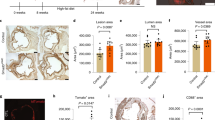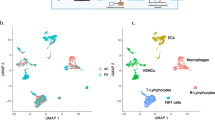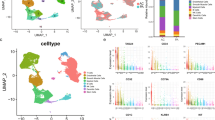Abstract
In response to various stimuli, vascular smooth muscle cells (SMCs) can de-differentiate, proliferate and migrate in a process known as phenotypic modulation. However, the phenotype of modulated SMCs in vivo during atherosclerosis and the influence of this process on coronary artery disease (CAD) risk have not been clearly established. Using single-cell RNA sequencing, we comprehensively characterized the transcriptomic phenotype of modulated SMCs in vivo in atherosclerotic lesions of both mouse and human arteries and found that these cells transform into unique fibroblast-like cells, termed ‘fibromyocytes’, rather than into a classical macrophage phenotype. SMC-specific knockout of TCF21—a causal CAD gene—markedly inhibited SMC phenotypic modulation in mice, leading to the presence of fewer fibromyocytes within lesions as well as within the protective fibrous cap of the lesions. Moreover, TCF21 expression was strongly associated with SMC phenotypic modulation in diseased human coronary arteries, and higher levels of TCF21 expression were associated with decreased CAD risk in human CAD-relevant tissues. These results establish a protective role for both TCF21 and SMC phenotypic modulation in this disease.
This is a preview of subscription content, access via your institution
Access options
Access Nature and 54 other Nature Portfolio journals
Get Nature+, our best-value online-access subscription
$29.99 / 30 days
cancel any time
Subscribe to this journal
Receive 12 print issues and online access
$209.00 per year
only $17.42 per issue
Buy this article
- Purchase on Springer Link
- Instant access to full article PDF
Prices may be subject to local taxes which are calculated during checkout






Similar content being viewed by others
Data availability
High-throughput sequencing data (FASTQ) files for all scRNA-Seq, CITE-Seq and ChIP-Seq, as well as cell–gene count matrices for all scRNA-Seq and CITE-Seq experiments, have been deposited in the Gene Expression Omnibus database with the SuperSeries reference number GSE131780. These data were used to generate the images in Figs. 1–5 and Extended Data Figs. 2–5. FASTQ files and processed data are also available from the corresponding author upon request.
References
Davies, M. J., Richardson, P. D., Woolf, N., Katz, D. R. & Mann, J. Risk of thrombosis in human atherosclerotic plaques: role of extracellular lipid, macrophage, and smooth muscle cell content. Br. Heart J. 69, 377–381 (1993).
Libby, P. & Aikawa, M. Stabilization of atherosclerotic plaques: new mechanisms and clinical targets. Nat. Med. 8, 1257–1262 (2002).
Ross, R. & Glomset, J. A. Atherosclerosis and the arterial smooth muscle cell: proliferation of smooth muscle is a key event in the genesis of the lesions of atherosclerosis. Science 180, 1332–1339 (1973).
Bennett, M. R., Sinha, S. & Owens, G. K. Vascular smooth muscle cells in atherosclerosis. Circ. Res. 118, 692–702 (2016).
Gomez, D. & Owens, G. K. Smooth muscle cell phenotypic switching in atherosclerosis. Cardiovasc. Res. 95, 156–164 (2012).
Shankman, L. S. et al. KLF4-dependent phenotypic modulation of smooth muscle cells has a key role in atherosclerotic plaque pathogenesis. Nat. Med. 21, 628–637 (2015).
Gomez, D., Shankman, L. S., Nguyen, A. T. & Owens, G. K. Detection of histone modifications at specific gene loci in single cells in histological sections. Nat. Methods 10, 171–177 (2013).
Schunkert, H. et al. Large-scale association analysis identifies 13 new susceptibility loci for coronary artery disease. Nat. Genet. 43, 333–338 (2011).
Miller, C. L. et al. Disease-related growth factor and embryonic signaling pathways modulate an enhancer of TCF21 expression at the 6q23.2 coronary heart disease locus. PLoS Genet. 9, e1003652 (2013).
Miller, C. L. et al. Coronary heart disease-associated variation in TCF21 disrupts a miR-224 binding site and miRNA-mediated regulation. PLoS Genet. 10, e1004263 (2014).
Dettman, R. W., Denetclaw, W. Jr, Ordahl, C. P. & Bristow, J. Common epicardial origin of coronary vascular smooth muscle, perivascular fibroblasts, and intermyocardial fibroblasts in the avian heart. Dev. Biol. 193, 169–181 (1998).
Winter, E. M. & Gittenberger-de Groot, A. C. Epicardium-derived cells in cardiogenesis and cardiac regeneration. Cell. Mol. Life Sci. 64, 692–703 (2007).
Acharya, A. et al. The bHLH transcription factor Tcf21 is required for lineage-specific EMT of cardiac fibroblast progenitors. Development 139, 2139–2149 (2012).
Nurnberg, S. T. et al. Coronary artery disease associated transcription factor TCF21 regulates smooth muscle precursor cells that contribute to the fibrous cap. PLoS Genet. 11, e1005155 (2015).
Herring, B. P., Hoggatt, A. M., Burlak, C. & Offermanns, S. Previously differentiated medial vascular smooth muscle cells contribute to neointima formation following vascular injury. Vasc. Cell 6, 21 (2014).
Wirth, A. et al. G12-G13-LARG-mediated signaling in vascular smooth muscle is required for salt-induced hypertension. Nat. Med. 14, 64–68 (2008).
Madisen, L. et al. A robust and high-throughput Cre reporting and characterization system for the whole mouse brain. Nat. Neurosci. 13, 133–140 (2010).
Zheng, G. X. et al. Massively parallel digital transcriptional profiling of single cells. Nat. Commun. 8, 14049 (2017).
Dobnikar, L. et al. Disease-relevant transcriptional signatures identified in individual smooth muscle cells from healthy mouse vessels. Nat. Commun. 9, 4567 (2018).
Kitchen, C. M., Cowan, S. L., Long, X. & Miano, J. M. Expression and promoter analysis of a highly restricted integrin alpha gene in vascular smooth muscle. Gene 513, 82–89 (2013).
Stoeckius, M. et al. Simultaneous epitope and transcriptome measurement in single cells. Nat. Methods 14, 865–868 (2017).
Jacobsen, K. et al. Diverse cellular architecture of atherosclerotic plaque derives from clonal expansion of a few medial SMCs. JCI Insight 2, 95890 (2017).
Vengrenyuk, Y. et al. Cholesterol loading reprograms the microRNA-143/145–myocardin axis to convert aortic smooth muscle cells to a dysfunctional macrophage-like phenotype. Arterioscler. Thromb. Vasc. Biol. 35, 535–546 (2015).
Sazonova, O. et al. Characterization of TCF21 downstream target regions identifies a transcriptional network linking multiple independent coronary artery disease loci. PLoS Genet. 11, e1005202 (2015).
Franzen, O. et al. Cardiometabolic risk loci share downstream cis- and trans-gene regulation across tissues and diseases. Science 353, 827–830 (2016).
Clement, N. et al. Notch3 and IL-1β exert opposing effects on a vascular smooth muscle cell inflammatory pathway in which NF-κB drives crosstalk. J. Cell Sci. 120, 3352–3361 (2007).
Pidkovka, N. A. et al. Oxidized phospholipids induce phenotypic switching of vascular smooth muscle cells in vivo and in vitro. Circ. Res. 101, 792–801 (2007).
Dandre, F. & Owens, G. K. Platelet-derived growth factor-BB and Ets-1 transcription factor negatively regulate transcription of multiple smooth muscle cell differentiation marker genes. Am. J. Physiol. Heart Circ. Physiol. 286, H2042–H2051 (2004).
Rong, J. X., Shapiro, M., Trogan, E. & Fisher, E. A. Transdifferentiation of mouse aortic smooth muscle cells to a macrophage-like state after cholesterol loading. Proc. Natl Acad. Sci. USA 100, 13531–13536 (2003).
Rong, J. X., Berman, J. W., Taubman, M. B. & Fisher, E. A. Lysophosphatidylcholine stimulates monocyte chemoattractant protein-1 gene expression in rat aortic smooth muscle cells. Arterioscler. Thromb. Vasc. Biol. 22, 1617–1623 (2002).
Allahverdian, S., Chehroudi, A. C., McManus, B. M., Abraham, T. & Francis, G. A. Contribution of intimal smooth muscle cells to cholesterol accumulation and macrophage-like cells in human atherosclerosis. Circulation 129, 1551–1559 (2014).
Kanisicak, O. et al. Genetic lineage tracing defines myofibroblast origin and function in the injured heart. Nat. Commun. 7, 12260 (2016).
Chappell, J. et al. Extensive proliferation of a subset of differentiated, yet plastic, medial vascular smooth muscle cells contributes to neointimal formation in mouse injury and atherosclerosis models. Circ. Res. 119, 1313–1323 (2016).
Butler, A., Hoffman, P., Smibert, P., Papalexi, E. & Satija, R. Integrating single-cell transcriptomic data across different conditions, technologies, and species. Nat. Biotechnol. 36, 411–420 (2018).
Satija, R., Farrell, J. A., Gennert, D., Schier, A. F. & Regev, A. Spatial reconstruction of single-cell gene expression data. Nat. Biotechnol. 33, 495–502 (2015).
Kasowski, M. et al. Variation in transcription factor binding among humans. Science 328, 232–235 (2010).
Li, H. & Durbin, R. Fast and accurate short read alignment with Burrows–Wheeler transform. Bioinformatics 25, 1754–1760 (2009).
Zhang, Y. et al. Model-based analysis of ChIP-Seq (MACS). Genome Biol. 9, R137 (2008).
Acknowledgements
The authors are grateful to G. Owens for providing TgMyh11-Cre, ApoE−/− animals and experimental protocols. The authors are also grateful to L. Román for assistance with developing the human coronary digestion protocol. This work was supported by NIH grant F32HL129670 and AHA grant 18CDA34110206 (both to R.C.W.), and NIH grants K08HL133375 (to J.B.K.), R00HL125912 (to C.L.M.), R01HL109512 (to T.Q.), R01HL134817 (to T.Q.), R33HL120757 (to T.Q.), R01DK107437 (to T.Q.), R01HL139478 (to T.Q.), 1R01HL141371 (to J.C.W.) and 17GRNT33660474 AHA (to M.D.T.). The sequencing data were generated on an Illumina HiSeq 4000 that was purchased with funds from NIH under award number S10OD018220. Cell sorting was performed on an instrument in the Shared FACS Facility obtained using NIH S10 Shared Instrument Grant S10RR025518-01.
Author information
Authors and Affiliations
Contributions
R.C.W. designed and performed all scRNA-Seq experiments, analyzed the scRNA-Seq data, performed the RNAscope in situ hybridization assays, performed and analyzed the CITE-Seq and FACS experiments, analyzed the immunofluorescence data, performed the eQTL analyses, assisted with mouse colony breeding, drafted the manuscript and led the study. D.W. assisted with the design of the scRNA-Seq experiments and performed scRNA-Seq capture and library preparation for all samples. D.T.P. performed scRNA-Seq capture and helped obtain human coronary samples. J.C. assisted with the scRNA-Seq capture, library preparation and sequencing. T.N. performed qPCR experiments, analyzed the qPCR data and performed TCF21 ChIP-Seq. M.P., C.L.M., B.L. and S.B.M. performed the eQTL analyses. R.K. performed the immunohistochemistry experiments and bred the mouse colonies. M.N. performed and analyzed the immunohistochemistry experiments. K.Z., M.A. and R.C. assisted with network analysis. T.K.K., R.F. and Y.J.W. prepared the human tissue samples. M.D.T. and J.C.W. provided critical expert guidance on the manuscript. J.B.K. helped plan the mouse in situ histology studies, managed the mouse colonies, performed the TCF21 overexpression experiment, performed the quantitative immunohistochemistry analysis of lesion characteristics and conceived the study. T.Q. conceived and supervised the study. All authors discussed the results and contributed critical review to the manuscript.
Corresponding author
Ethics declarations
Competing interests
The authors declare no competing interests.
Additional information
Peer review information: Michael Basson was the primary editor on this article and managed its editorial process and peer review in collaboration with the rest of the editorial team.
Publisher’s note: Springer Nature remains neutral with regard to jurisdictional claims in published maps and institutional affiliations.
Extended data
Extended Data Fig. 1 Design of mouse experiments.
a, Alleles present in SMClin and SMClin-KO mice. KO (knockout) refers to Tcf21, lin, lineage tracing; Tg, transgene; ΔSMC, SMC cell-specific KO. b, Mice were maintained on a chow diet from birth until 7 weeks of age, then underwent gavage and HFD treatment. For the scRNA-Seq, RNAscope, CITE-Aeq, histology involving BODIPY and FACS staining experiments (upper timeline), mice were gavaged only at 7 weeks of age, before the onset of HFD, as denoted by red arrows. For the scRNA-Seq experiments, mice were sacrificed at baseline (72 h after initial tamoxifen gavage), or after 8 or 16 weeks of HFD. For the RNAscope experiments, mice were sacrificed after either 8 or 16 weeks of HFD. For the CITE-Seq experiment, mice were sacrificed after 16 weeks of HFD. For the BODIPY studies, mice were sacrificed after 16 weeks of HFD. For the FACS staining experiment, two mice (one after 12 weeks HFD and another after 15 weeks HFD) were used. For quantitative histology experiments (lower timeline), mice were gavaged at 7 weeks of age, after 8 weeks of HFD and after 16 weeks of HFD (48 h before sacrifice), as denoted by red arrows. For these quantitative histology experiments, all mice were sacrificed after 16 weeks of HFD. c, FACS workflow for isolating single cells from the mouse aortic root.
Extended Data Fig. 2 SMC phenotypic modulation in the mouse aortic root.
a–d, t-SNE visualization of cell types present in the WT mouse aortic root from all time points overlaid with the expression of Col1a1, Acta2, Sca1 and Lgals3 (n = 9 mice). e–g, RNAscope staining for Lum (green) and tdT (red) in a plaque after 8 weeks of HFD (e), the non-diseased media of a mouse on 16 weeks HFD (f) and a baseline healthy aorta (g). h, RNAscope negative control. Images in e–h are representative of two experiments and scale bars indicate 25 μm. i, t-SNE visualization of cell types present in the WT mouse aortic root from all time points overlaid with osteopontin (Spp1) expression (n = 9 mice). j,k, RNAscope co-localization of Spp1 (green) and tdT (red) in a plaque after 16 weeks of HFD. Yellow arrows indicate co-localization of Spp1 and tdT. l, RNAscope negative control. Images from j–l are representative of four experiments, and scale bars indicate 50 μm. m, Heat map representation of the Euclidean distance between cell cluster centroids in 20-dimensional principal component space with the smallest distances in yellow and the largest distances in black. Data are after 16 weeks of HFD. n, Staining of a single-cell suspension from the atherosclerotic mouse aortic root and ascending aorta with antibodies against the macrophage markers Cd16 and Cd32, and analysis of co-expression with the tdT SMC lineage marker. Data are from one experiment and n = 2 mice (after 12 and 15 weeks of HFD). o–t, Single cells from the atherosclerotic mouse aortic root and ascending aorta at 16 weeks HFD were incubated with DNA-barcoded antibodies against the macrophage markers Cd16, Cd32, Cd11b, Cd64, Cd86 and F4/80 before undergoing scRNA-Seq (CITE-Seq), yielding simultaneous transcriptomic and antibody binding data within each individual cell. o, Cell type assignments were determined with scRNA-Seq as described previously. p–t, Quantitative antibody binding within each cell type. Results are from one experiment and n = 2 mice.
Extended Data Fig. 3 Additional characteristics of SMClin versus SMClin-KO mice.
a,b, Tcf21 expression in SMC lineage-labeled cells from SMClin (WT) and SMClin-KO (KO) mice from all time points combined (n = 13 mice). a, Tcf21 expression for all WT cells (left; minimum = 0; maximum = 2.55; mean = 0.071) and all KO cells (right; minimum = 0; maximum = 1.97; mean = 0.004). b, Mean Tcf21 expression visualized for all SMC lineage-labeled WT and KO cells. c, Total Lgals3+ area in the lesion is reduced in SMClin-KO mice. d, Cd68 immunohistochemistry quantification (left) and representative images (right). Scale bars represent 100 μm. e, Lesion area, normalized to the total vessel area. Data from c–e are after 16 weeks HFD, and analyzed using a two-sided Student’s t-test. Error bars indicate standard error.
Extended Data Fig. 4 Joint clustering approach identifies human phenotypically modulated SMCs.
a, Joint clustering of mouse and human datasets using canonical correlation analysis (CCA) as per the Seurat package. b, The shared mouse/human cluster containing bona fide SMC lineage-traced, phenotypically modulated SMCs (fibromyocytes) from the mouse is highlighted in red. c, Mouse cells in the shared mouse/human fibromyocyte cluster in b are highlighted in the independently clustered mouse dataset, confirming their location within the known fibromyocyte cell cluster. d, Human cells in the shared mouse/human fibromyocyte cluster in b are highlighted in the independently clustered human dataset, illustrating their location predominantly in the ‘fibromyocyte’ cluster (also shown in brown in Fig. 4d). e, All joint mouse/human clusters in a were mapped back to the human dataset. Agreement is identified in cell type assignment between the joint clustering approach and the independently clustered human dataset.
Extended Data Fig. 5 Human phenotypically modulated SMCs.
a, t-SNE visualization of cell types in the right coronary artery of four patients, overlaid with LUM expression. Expression levels are indicated by scales in the lower right. b, TNFRSF11B RNAscope staining in a human coronary artery section. Hybridization events are seen as red dots. c, A negative control RNAscope probe shows no staining. The images in b and c are representative of four experiments, and the scale bars represent 50 μm. d, Heat map representation of the Euclidean distance between cell cluster centroids in 20-dimensional principal component space, with the smallest distances in yellow and the largest distances in black. The relationship between ‘fibromyocyte’ and ‘fibroblast 2’ clusters is highlighted with white asterisks. The ‘fibromyocyte’, ‘SMC’ and the main ‘macrophage’ clusters are denoted by black asterisks. e,f, t-SNE visualization of cell types in the right coronary artery of four patients overlaid with CD68 expression (e) and TCF21 expression (f). g, UCSC Genome Browser shots of representative TCF21 ChIP-Seq peaks within the PRELP and MYH11 genes, which are highly correlated and anticorrelated, respectively, with TCF21 and the fibromyocyte phenotype. Images are from one ChIP-Seq experiment.
Extended Data Fig. 6 Association of genome-wide significant CAD risk SNPs at the 6q23.2 locus with TCF21 expression.
Seven SNPs in the 6q23.2 locus were associated with CAD at genome-wide significance. The association between risk and protective genotypes and TCF21 expression for each of these SNPs was determined using the GTEx database in CAD-relevant tissues and a cohort of 52 HCASMC lines. The number of independent tissue samples included for each SNP is indicated in the GTEx data (‘N’), and n = 52 cell lines for the HCASMC data. In each box plot, the middle line represents the median, the box represents the first to third quartile range, and whiskers represent 1.5× the interquartile range.
Supplementary information
Supplementary Information
Supplementary Tables 1–5
Source data
Source Data Fig. 3
Statistical source data for Fig. 3.
Source Data Fig. 5
Statistical source data for Fig. 5.
Source Data Extended Data Fig. 3
Statistical source data for Extended Data Fig. 3.
Rights and permissions
About this article
Cite this article
Wirka, R.C., Wagh, D., Paik, D.T. et al. Atheroprotective roles of smooth muscle cell phenotypic modulation and the TCF21 disease gene as revealed by single-cell analysis. Nat Med 25, 1280–1289 (2019). https://doi.org/10.1038/s41591-019-0512-5
Received:
Accepted:
Published:
Issue Date:
DOI: https://doi.org/10.1038/s41591-019-0512-5
This article is cited by
-
Spatial multi-omics: novel tools to study the complexity of cardiovascular diseases
Genome Medicine (2024)
-
Emerging applications of single-cell profiling in precision medicine of atherosclerosis
Journal of Translational Medicine (2024)
-
Dysregulated cellular metabolism in atherosclerosis: mediators and therapeutic opportunities
Nature Metabolism (2024)
-
An epigenetic switch in macrophages promotes fibrosis in the failing heart
Nature Cardiovascular Research (2024)
-
Suppression of IL-1β promotes beneficial accumulation of fibroblast-like cells in atherosclerotic plaques in clonal hematopoiesis
Nature Cardiovascular Research (2024)



